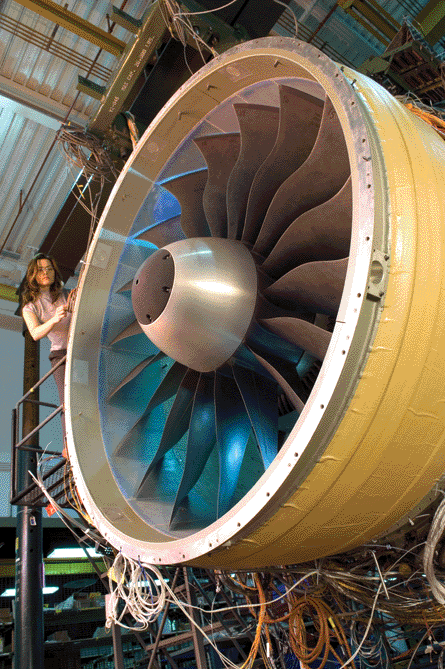The engine Pratt & Whitney believes will power the next generation of short-haul airliners has been tested for the first time. The Geared Turbofan (GTF) demonstrator engine ran for the first time, ahead of schedule, at the company’s advanced test facility in West Palm Beach, Florida.
Ground testing will run through to May 2008, and flight testing on P&W’s 747 flying test bed will begin in mid-2008. “We are confident that this demonstrator engine will meet all performance expectations and validate the game-changing characteristics of the Geared Turbofan engine.” says Bob Saia, vice president of P&W’s next generation product family.
The GTF engine is designed to give improvements in fuel burn estimated at around 12%, along with significant reductions in engine noise, emissions and operating costs. The engine has a fan drive gear system allows the engine’s fan to operate at a different speed to that of the low-pressure compressor and turbine, resulting in greater fuel efficiency. The slower fan speed results in lower noise levels.
Last month P&W announced the GTF engine has been selected by Mitsubishi Heavy Industries to power the proposed Mitsubishi Regional Jet. The sole-source agreement is the first airframe application for the engine, which is expected to enter service in 2013. P&W is also hopeful of selection for Bombardier’s proposed CSeries regional jet.
P&W is promoting the concept to both Boeing and Airbus, hoping they will select the concept for their replacements for the 737 and A320 families, expected to be firmed up some time in the next decade. But other concepts are also in the frame, including unducted ‘open rotor’ engines and refined versions of existing turbofan designs with higher bypass ratios than at present.
P&W claims open-rotor technology will not offer an improvement over the GTF engine. The open-rotor fan diameter may be nearly twice as wide as ducted nacelles, says Saia, and the size of these engines will add weight and require larger struts if mounted on the wing. The airframers may be forced to mount the engines on the body of the fuselage, adding even more structural weight. A wing-mounted open rotor fan also would sharply increase noise, requiring additional insulation inside the airframe.

“We still don't see how we overcome the hurdles of what we're talking about,” Saia says. With GTF, he adds, “you can get open-rotor fuel efficiency without sacrificing any noise”.
P&W president Steve Finger recently said GTF represented the best option, saying: “GTF is, I believe, the only workable solution over the next 15 to 20 years.” However, P&W may also have to convince other engine manufacturers that GTF is the way to go as it is involved with two major engine JVs, International Aero Engines and Engine Alliance, and its partners are likely to be equally keen to promote their own technologies.
Back to the rest of Dubai 2007 show news, blogs, and pictures
Source: Flight Daily News























